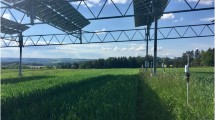Abstract
An especial method was applied for calculating the photosynthetic productivity of oak (Quercus robur L.) stand. The methodological basis is that the efficiency of photosynthetic utilization of intercepted PAR over the daylight period depends on environmental conditions and distribution of PAR within the canopy. This method was also used to determine the photosynthetic productivity of individual trees within the stand and to estimate the contribution of trees with various extents of growth retardment to the total photosynthetic productivity. For the oak stand in the forest-steppe region, the photosynthetic efficiency was expressed as a function of climatic variables such as solar irradiance day sum, day average temperature, air humidity, and water availability (quantified as the predawn leaf water potential, PLWP). This functional dependence differed for sun-exposed and shade leaves. Under optimum water availability (PLWP = −0.5 MPa), the photosynthetic productivity of a 60-year-old oak stand amounted 44.5 t C/(ha year) but it declined with the decrease in water availability. Under severe water deficit, when PLWP dropped to −2.1 MPa, the photosynthetic productivity decreased 17-fold and equaled 2.6 t C/(ha year). The strongest decline in photosynthetic productivity occurred on sunny days under moisture deficit in dominant and codominant trees belonging to growth classes I and II.
Similar content being viewed by others
Abbreviations
- LAI:
-
leaf area index of vegetation (shoot)
- NPP:
-
net photosynthetic productivity; photosynthetic efficiency—coefficient of photosynthetic utilization of intercepted solar energy
- PAR:
-
photosynthetically active radiation
- PLWP:
-
predawn leaf (shoot) water potential
- PP:
-
photosynthetic productivity
REFERENCES
Monsi, M. and Saeki, T., Uber den Lichtfaktor in den Pflanzengesellschaften und seine Bedeutung fur die Stoffproduktion, Jpn. J. Bot., 1953, vol. 14, pp. 22–55.
Monsi, M., Mathematical Models of Plant Communities, Functioning of Terrestrial Ecosystems at the Primary Production Level: Proc. Copenhagen Symp., Eckardt, F.E., Ed., Paris: UNESCO, 1968, pp. 131–150.
Hozumi, K., Kirita, H., and Nishioke, M., Estimation of Canopy Photosynthesis and Its Seasonal Change in a Warm Temperate Evergreen Oak Forest of Minamata (Japan), Photosynthetica, 1972, vol. 6, pp. 158–168.
Arneth, A., Kelliher, F.M., McSeveny, T.M., and Byers, J.N., Net Ecosystem Productivity, Net Primary Productivity and Ecosystem Carbon Sequestration in a Pinus radiata Plantation Subject to Soil Water Deficit, Tree Physiol., 1998, vol. 18, pp. 785–793.
Chmora, S.N., Light Curves of Photosynthesis in Maize Stands, Fotosinteziruyushchie sistemy vysokoi produktivnosti (Photosynthetic Systems of High Productivity), Nichiporovich, A.A., Ed., Moscow: Nauka, 1966, pp. 142–149.
Molchanov, A.G., Ekofiziologicheskoe izuchenie produktivnosti drevostoev (Ecological and Physiological Investigations of Tree Stand Productivity), Moscow: Nauka, 1983.
Molchanov, A.G., Effect of Environment on Change in Photosynthesis Intensity for Quercus robur, Lesovedenie, 2002, no. 6, pp. 13–22.
Molchanov, A.G., Photosynthetic Utilization Efficiency of Absorbed Photosynthetically Active Radiation by Scots Pine and Birch Forest Stands in the Southern Taiga, Tree Physiol, 2000, vol. 20, pp. 1137–1148.
Selochnik, N.N., Il’yushenko, A.F., and Kondrasheva, N.K., Oak Powdery Mildew and Its Distribution in Tree Stand Canopy, Lesovedenie, 1994, no. 4, pp. 61–70.
Molchanov, A.G. and Molchanova, T.G., Distribution of Solar Radiation in Oak Stand Canopy, Lesovedenie, 2005, no. 1, pp. 52–62.
Czarnowski, M., Important Measure Units and Symbols Used in Plant Physiology, Acta Physiol. Plant., 1996, vol. 18, pp. 173–181.
Tooming, Kh.G. and Gulyaev, B.I., Metodika izmereniya fotosinteticheski aktivnoi radiatsii (Method for Measuring of Photosynthetic Active Radiation), Moscow: Nauka, 1967.
Molchanov, A.G. and Molchanova, T.G., The Water Potential of Oak Leaves before Dawn as an Indicator of Plant Water Supply, Lesovedenie, 2000, no. 2, pp. 72–74.
Scholander, P.F., Hammel, H.T., Bradstreet, E.D., and Hemmingsen, E.A., Sap Pressure in Vascular Plants. Negative Hydrostatic Pressure Can Be Measured in Plants, Science, 1965, vol. 148, pp. 339–346.
Rakhi, M.O., The Equipment for Investigation of Water Potential Components in Leaves, Fiziol. Rast. (Moscow), 1973, vol. 20, pp. 215–221 (Sov. Plant Physiol., Engl. Transl.).
Molchanov, A.G. and Khazanov, V.S., Measuring and Calculation of PAR Absorption in Pine Branches, Lesovedenie, 1975, no. 2, pp. 75–79.
Vygodskaya, N.N., Age Dynamics of Optical Properties of Highly Productive Trees in Ash-Aegopodium Forests, Vzaimootnosheniya komponentov biogeotsenoza v listvennykh molodnyakakh (Interrelation between Components of the Biocenosis in Deciduous Young Trees), Molchanov, A.A., Ed., Moscow: Nauka, 1970, pp. 78–107.
Tooming, Kh.G., Theoretical Possible Photosynthetical Efficiency Taking into Account Respiration, Voprosy effektivnosti fotosinteza (Photosynthetic Efficiency), Ross, Yu., Ed., Tartu: Tartus. Gos. Univ., 1969, pp. 5–25.
Rauner, Yu.L., Methodology of Experimental Investigation of Heat Balance in Forests and Woodless Land-scapes, Teplovoi i radiatsionnyi balans estestvennoi rasti-tel’nosti i s.-kh. polei (Heat and Radiation Balance in Natural Vegetation and Agricultural Fields), Rauner, Yu.L., Ed., Moscow: Nauka, 1965, pp. 7–22.
Rauner, Yu.L., Teplovoi balans rastitel’nogo pokrova (Heat Balance in Plant Covering), Leningrad: Gidrometeoizdat, 1972.
Rudnev, N.I., Radiatsionnyi balans lesa (Radiation Balance in the Forest), Moscow: Nauka, 1977.
Waring, R.H., Landsberg, J.J., and Williams, M., Net Primary Production of Forests: A Constant Fraction of Gross Primary Production, Tree Physiol., 1998, vol. 18, pp. 129–134.
Gifford, R.M., Plant Respiration in Productivity Models: Conceptualization, Representation, and Issues for Global Terrestrial Carbon Cycle Research, Funct. Plant Biol., 2003, vol. 30, pp. 171–186.
Il’yushenko, A.F., Dynamics of Annual Oak Death in Aegopodium-Sedge Oak Forests in Tellerman Forestry and Change in Taxation Parameters, Sostoyanie dubrav lesostepi (State of Oak Forests in Forest-Steppe Communities), Orlov, A.Ya. and Osipov, V.V., Eds., Moscow: Nauka, 1989, pp. 56–74.
Author information
Authors and Affiliations
Additional information
__________
Translated from Fiziologiya Rastenii, Vol. 52, No. 4, 2005, pp. 522–531.
Original Russian Text Copyright © 2005 by Molchanov.
Rights and permissions
About this article
Cite this article
Molchanov, A.G. Photosynthetic Productivity of Oak Stand under Variable Environmental Conditions and Water Availability. Russ J Plant Physiol 52, 463–472 (2005). https://doi.org/10.1007/s11183-005-0069-7
Received:
Issue Date:
DOI: https://doi.org/10.1007/s11183-005-0069-7




